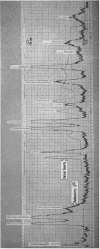Abstract
Three patients with idiopathic parkinsonism and six normal subjects were infused over a 4 hr period with 104.6 μc of dopamine-2-14C (3,4-dihydroxyphenylethylamine, 3-hydroxytyramine),1 the immediate precursor in the synthesis of the sympathetic neurohormone, noradrenaline (norepinephrine). Urine was collected during the infusion period, 0-2 hr, 2-4 hr, 4-8 hr, 8-24 hr, and thereafter for 4 additional days. Using a technique herein described, the various metabolic and biosynthetic products of dopamine, including noradrenaline and its metabolic products, were separated, identified, and their radioactivity measured.
The metabolic pattern of dopamine in the normal subject was compared to that of the three parkinsonism patients. The results indicate that in idiopathic parkinsonism there is a decrease in the recovery of free radioactive noradrenaline in the urine following an infusion of dopamine-2-14C and a slight shift toward dopamine metabolism. The latter is reflected by an increase in the following metabolites of dopamine: 3,4-dihydroxyphenylacetic acid and the conjugates of 3-methoxy-4-hydroxyphenylacetic acid, 3,4-dihydroxyphenylacetic acid, 3-methoxy-4-hydroxyphenylethanol and dopamine.
Full text
PDF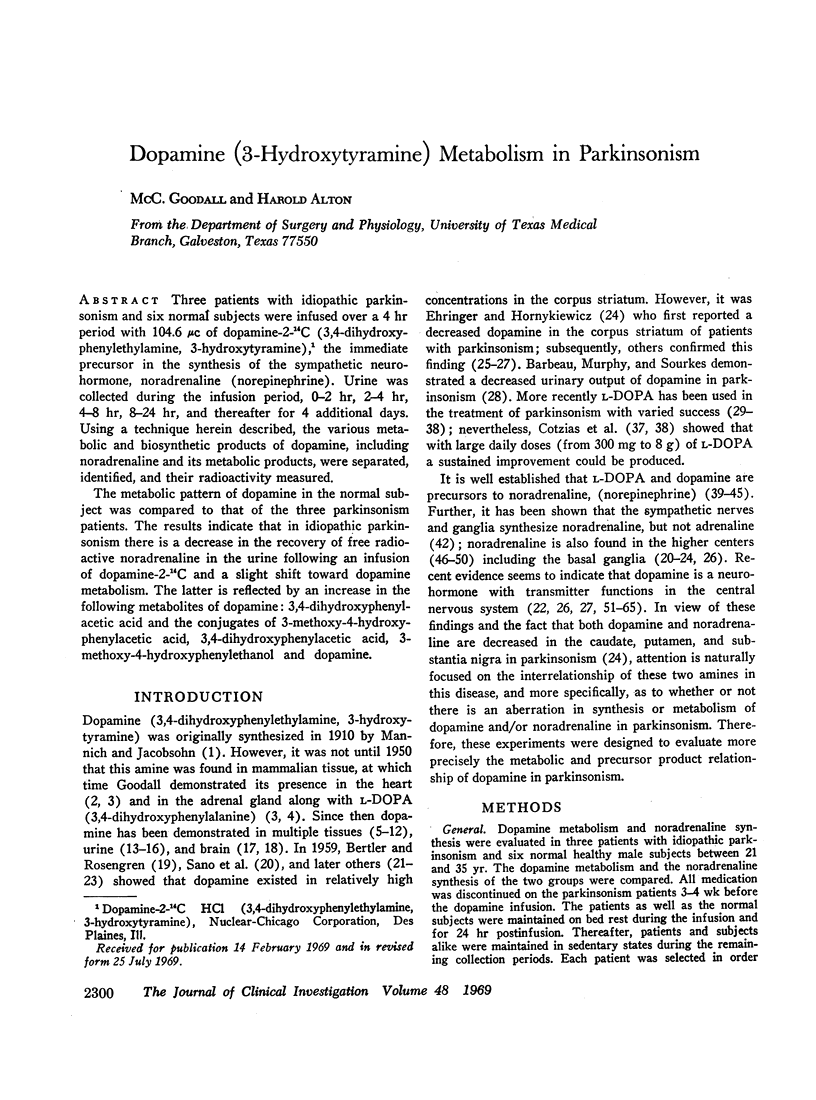
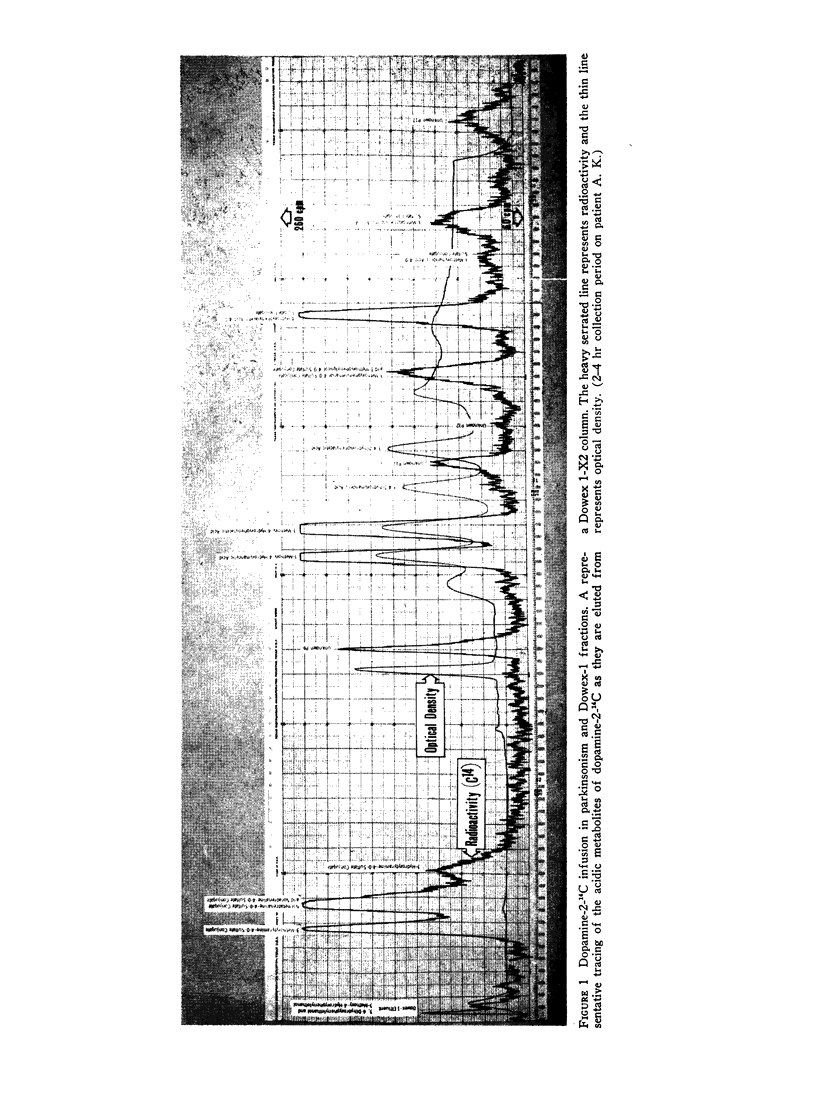
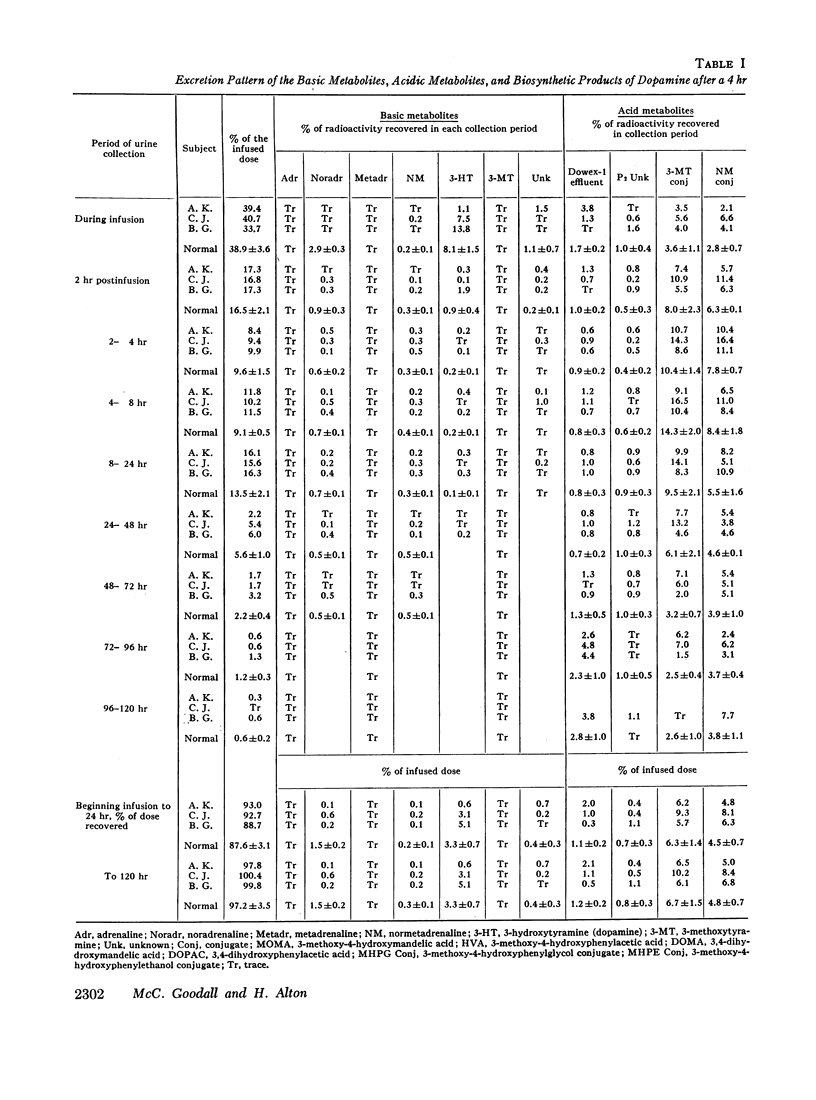
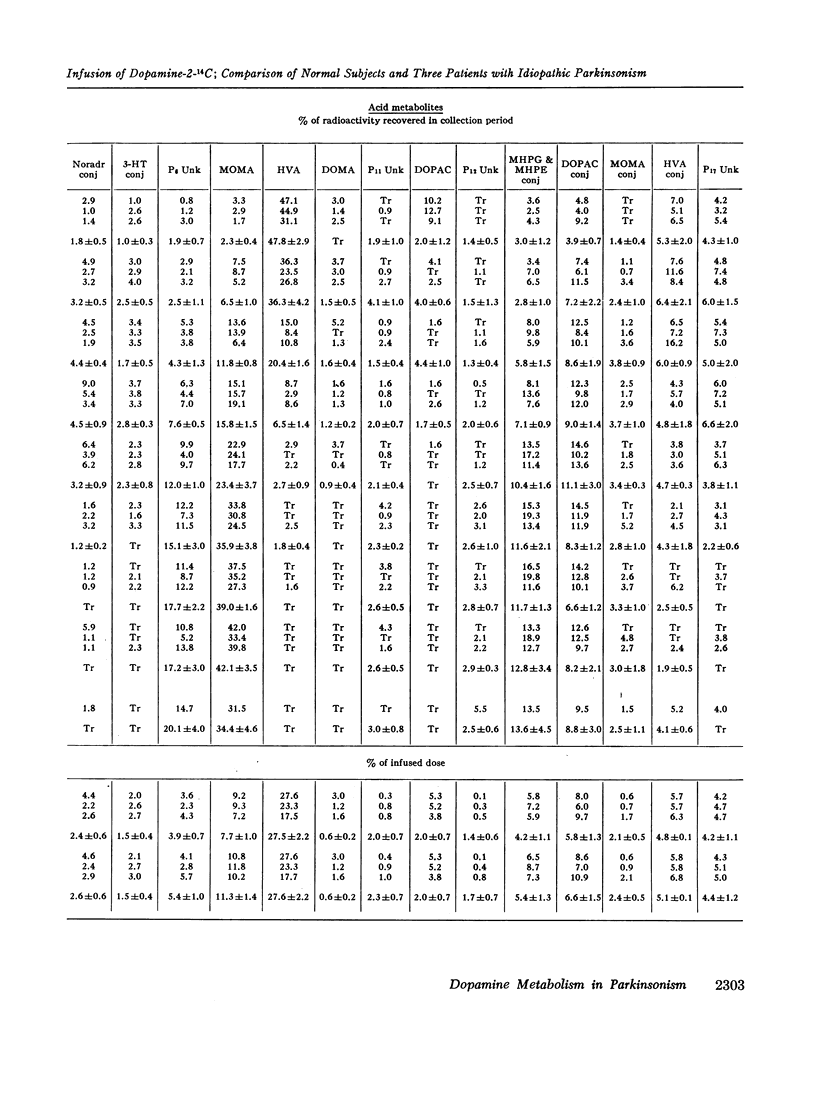

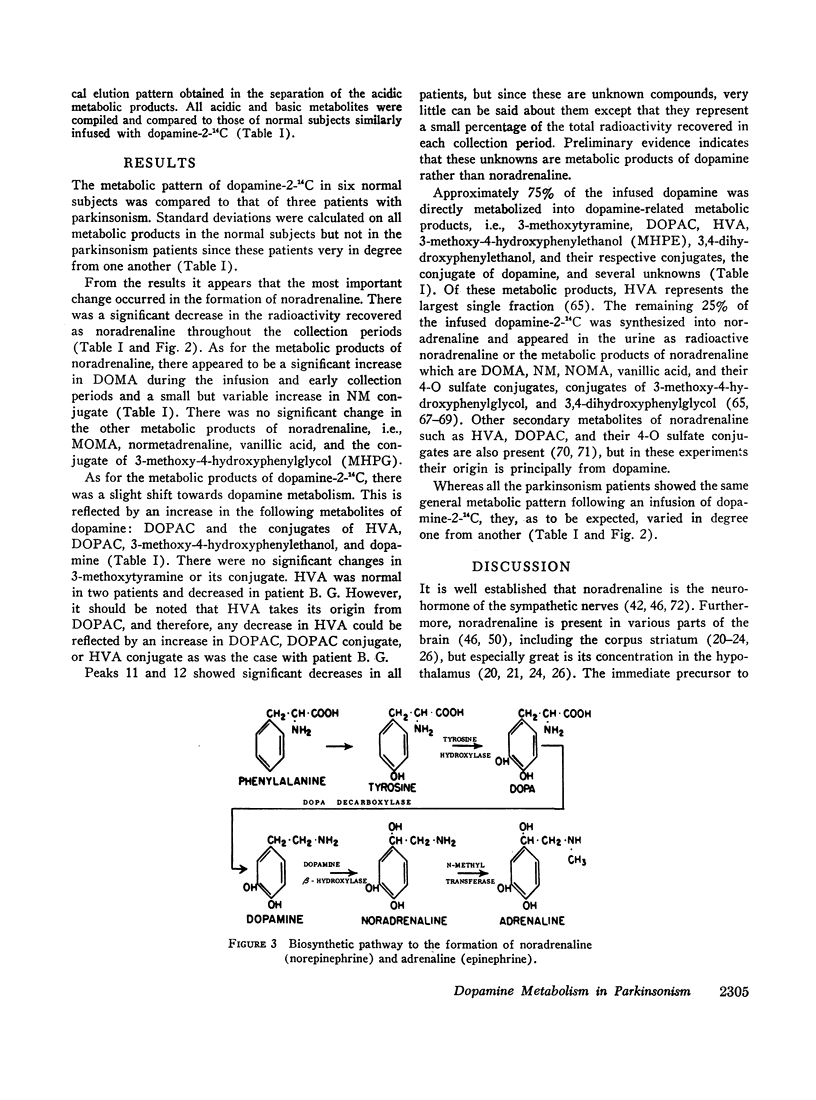
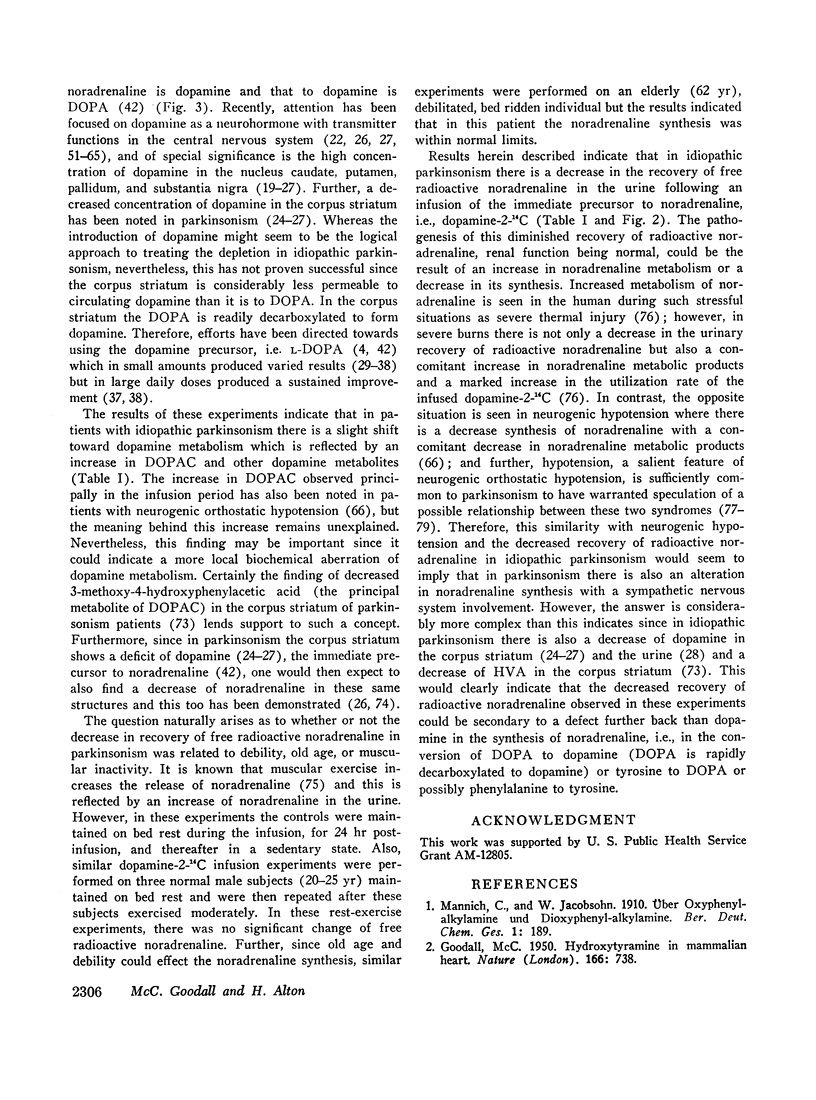
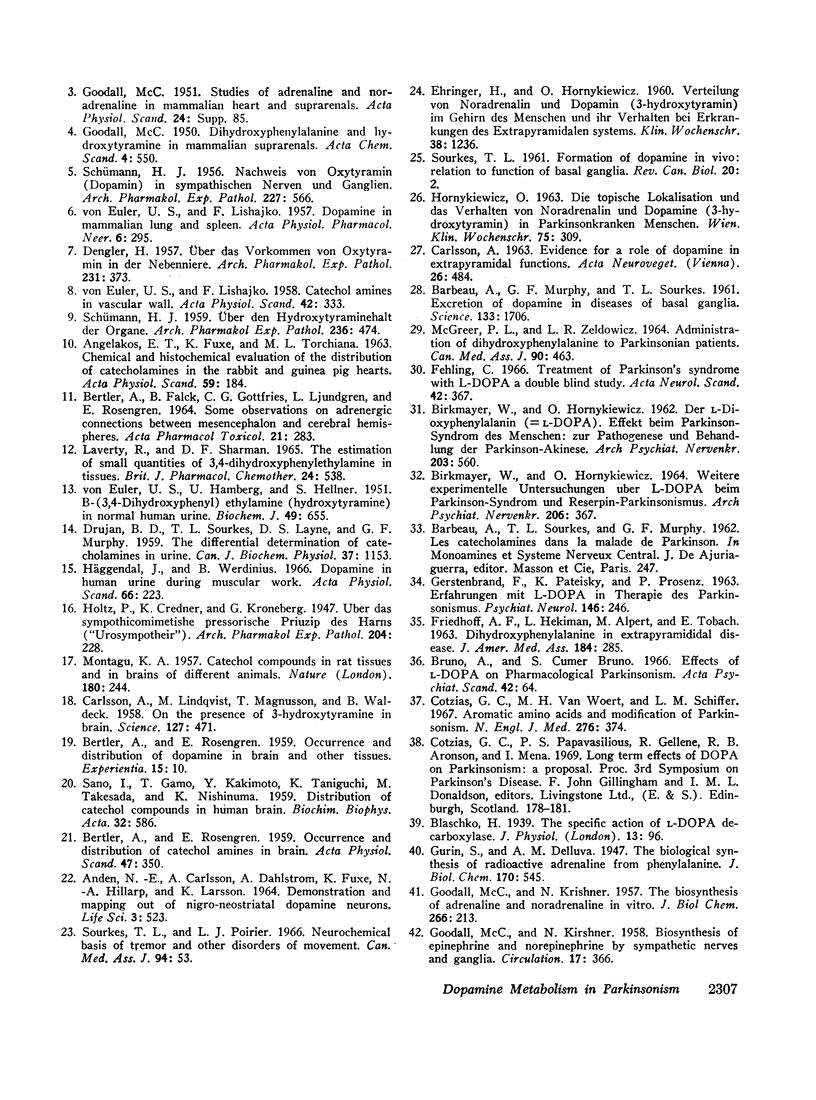
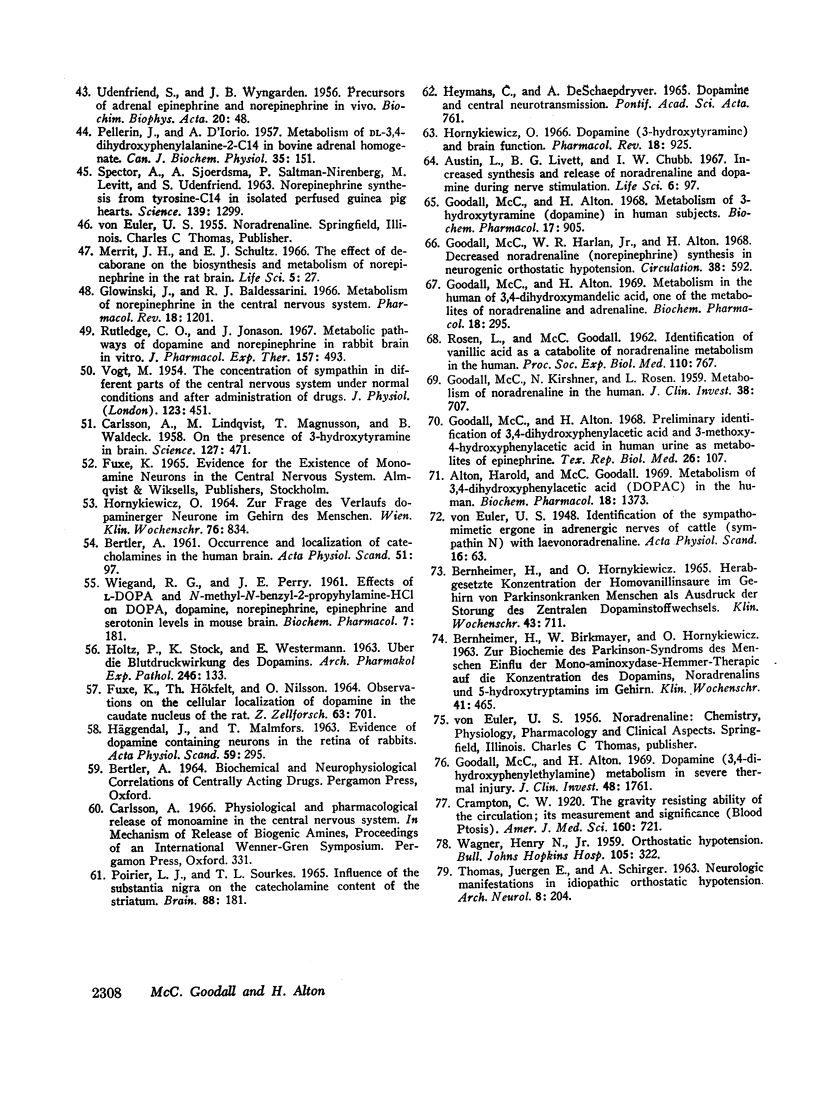
Images in this article
Selected References
These references are in PubMed. This may not be the complete list of references from this article.
- ANDEN N. E., CARLSSON A., DAHLSTROEM A., FUXE K., HILLARP N. A., LARSSON K. DEMONSTRATION AND MAPPING OUT OF NIGRO-NEOSTRIATAL DOPAMINE NEURONS. Life Sci. 1964 Jun;3:523–530. doi: 10.1016/0024-3205(64)90161-4. [DOI] [PubMed] [Google Scholar]
- ANGELAKOS E. T., FUXE K., TORCHIANA M. L. CHEMICAL AND HISTOCHEMICAL EVALUATION OF THE DISTRIBUTION OF CATECHOLAMINES IN THE RABBIT AND GUINEA PIG HEARTS. Acta Physiol Scand. 1963 Sep-Oct;59:184–192. doi: 10.1111/j.1748-1716.1963.tb02734.x. [DOI] [PubMed] [Google Scholar]
- Alton H., Goodall M. Metabolism of 3,4-dihydroxyphenylacetic acid (DOPAC) in the human. Biochem Pharmacol. 1969 Jun;18(6):1373–1379. doi: 10.1016/0006-2952(69)90250-0. [DOI] [PubMed] [Google Scholar]
- Austin L., Livett B. G., Chubb I. W. Increased synthesis and release of noradrenaline and dopamine during nerve stimulation. Life Sci. 1967 Jan 1;6(1):97–104. doi: 10.1016/0024-3205(67)90366-9. [DOI] [PubMed] [Google Scholar]
- BARBEAU A., MURPHY G. F., SOURKES T. L. Excretion of dopamine in diseases of basal ganglia. Science. 1961 May 26;133(3465):1706–1707. doi: 10.1126/science.133.3465.1706-a. [DOI] [PubMed] [Google Scholar]
- BERTLER A., FALCK B., GOTTFRIES C. G., LJUNGGREN L., ROSENGREN E. SOEME OBSERVATIONS ON ADRENERGIC CONNECTIONS BETWEEN MESENCEPHALON AND CEREBRAL HEMISPHERES. Acta Pharmacol Toxicol (Copenh) 1964;21:283–289. doi: 10.1111/j.1600-0773.1964.tb01792.x. [DOI] [PubMed] [Google Scholar]
- BERTLER A., ROSENGREN E. Occurrence and distribution of catechol amines in brain. Acta Physiol Scand. 1959 Dec 12;47:350–361. [PubMed] [Google Scholar]
- BERTLER A., ROSENGREN E. Occurrence and distribution of dopamine in brain and other tissues. Experientia. 1959 Jan 15;15(1):10–11. doi: 10.1007/BF02157069. [DOI] [PubMed] [Google Scholar]
- BIRKMAYER W., HORNYKIEWICZ O. WEITERE EXPERIMENTELLE UNTERSUCHUNGEN UEBER L-DOPA BEIM PARKINSON-SYNDROM UND RESERPIN-PARKINSONISMUS. Arch Psychiatr Nervenkr. 1964 Dec 2;206:367–381. doi: 10.1007/BF00341704. [DOI] [PubMed] [Google Scholar]
- BIRKMAYER W., HORNYKIEWICZ O. [The L-dihydroxyphenylalanine (L-DOPA) effect in Parkinson's syndrome in man: On the pathogenesis and treatment of Parkinson akinesis]. Arch Psychiatr Nervenkr Z Gesamte Neurol Psychiatr. 1962;203:560–574. doi: 10.1007/BF00343235. [DOI] [PubMed] [Google Scholar]
- Bernheimer H., Hornykiewicz O. Herabgesetzte Konzentration der Homovanillinsäure im Gehirn von parkinsonkranken Menschen als Ausdruck der Störung des zentralen Dopaminstoffwechsels. Klin Wochenschr. 1965 Jul 1;43(13):711–715. doi: 10.1007/BF01707066. [DOI] [PubMed] [Google Scholar]
- CARLSSON A. EVIDENCE FOR A ROLE OF DOPAMINE IN EXTRAPYRAMIDAL FUNCTIONS. Acta Neuroveg (Wien) 1964 Oct 2;26:484–493. doi: 10.1007/BF01252144. [DOI] [PubMed] [Google Scholar]
- CARLSSON A., LINDQVIST M., MAGNUSSON T., WALDECK B. On the presence of 3-hydroxytyramine in brain. Science. 1958 Feb 28;127(3296):471–471. doi: 10.1126/science.127.3296.471. [DOI] [PubMed] [Google Scholar]
- CARLSSON A., LINDQVIST M., MAGNUSSON T., WALDECK B. On the presence of 3-hydroxytyramine in brain. Science. 1958 Feb 28;127(3296):471–471. doi: 10.1126/science.127.3296.471. [DOI] [PubMed] [Google Scholar]
- Cotzias G. C., Van Woert M. H., Schiffer L. M. Aromatic amino acids and modification of parkinsonism. N Engl J Med. 1967 Feb 16;276(7):374–379. doi: 10.1056/NEJM196702162760703. [DOI] [PubMed] [Google Scholar]
- DENGLER H. Uber das Vorkommen von Oxytyramin in der Nebenniere. Naunyn Schmiedebergs Arch Exp Pathol Pharmakol. 1957;231(4):373–377. [PubMed] [Google Scholar]
- DRUJAN B. D., SOURKES T. L., LAYNE D. S., MURPHY G. F. The differential determination of catecholamines in urine. Can J Biochem Physiol. 1959 Oct;37:1153–1159. [PubMed] [Google Scholar]
- EHRINGER H., HORNYKIEWICZ O. [Distribution of noradrenaline and dopamine (3-hydroxytyramine) in the human brain and their behavior in diseases of the extrapyramidal system]. Klin Wochenschr. 1960 Dec 15;38:1236–1239. doi: 10.1007/BF01485901. [DOI] [PubMed] [Google Scholar]
- FRIEDHOFF A. J., HEKIMIAN L., ALPERT M., TOBACH E. Dihydroxyphenylalanine in extrapyramidal disease. JAMA. 1963 Apr 27;184:285–286. doi: 10.1001/jama.1963.73700170010010c. [DOI] [PubMed] [Google Scholar]
- FUXE K., HOEKFELT T., NILSSON O. OBSERVATIONS ON THE CELLULAR LOCALIZATION OF DOPAMINE IN THE CAUDATE NUCLEUS OF THE RAT. Z Zellforsch Mikrosk Anat. 1964 Aug 18;63:701–706. doi: 10.1007/BF00339917. [DOI] [PubMed] [Google Scholar]
- Fehling C. Treatment of Parkinson's syndrome with L-dopa. A double blind study. Acta Neurol Scand. 1966;42(3):367–372. doi: 10.1111/j.1600-0404.1966.tb01188.x. [DOI] [PubMed] [Google Scholar]
- GERSTENBRAND F., PATEISKY K., PROSENZ P. ERFAHRUNGEN MIT L-DOPA IN DER THERAPIE DES PARKINSONISMUS. Psychiatr Neurol (Basel) 1963;146:246–261. [PubMed] [Google Scholar]
- GOODALL M. Hydroxytyramine in mammalian heart. Nature. 1950 Oct 28;166(4226):738–738. doi: 10.1038/166738a0. [DOI] [PubMed] [Google Scholar]
- GOODALL M., KIRSHNER N. Biosynthesis of adrenaline and noradrenaline in vitro. J Biol Chem. 1957 May;226(1):213–221. [PubMed] [Google Scholar]
- GOODALL M., KIRSHNER N. Biosynthesis of epinephrine and norepinephrine by sympathetic nerves and ganglia. Circulation. 1958 Mar;17(3):366–371. doi: 10.1161/01.cir.17.3.366. [DOI] [PubMed] [Google Scholar]
- GOODALL M., KIRSHNER N., ROSEN L. Metabolism of noradrenaline in the human. J Clin Invest. 1959 Apr;38(4):707–714. doi: 10.1172/JCI103850. [DOI] [PMC free article] [PubMed] [Google Scholar]
- Glowinski J., Baldessarini R. J. Metabolism of norepinephrine in the central nervous system. Pharmacol Rev. 1966 Dec;18(4):1201–1238. [PubMed] [Google Scholar]
- Goodall M. C., Alton H. Dopamine (3-hydroxytyramine) replacement and metabolism in sympathetic nerve and adrenal medullary depletions after prolonged thermal injury. J Clin Invest. 1969 Sep;48(9):1761–1767. doi: 10.1172/JCI106142. [DOI] [PMC free article] [PubMed] [Google Scholar]
- Goodall M. C., Harlan W. R., Jr, Alton H. Decreased noradrenaline (norepinephrine) synthesis in neurogenic orthostatic hypotension. Circulation. 1968 Sep;38(3):592–603. doi: 10.1161/01.cir.38.3.592. [DOI] [PubMed] [Google Scholar]
- Goodall M., Alton H. Metabolism in the human of 3, 4-dihydroxymandelic acid, one of the metabolites of noradrenaline and adrenaline. Biochem Pharmacol. 1969 Feb;18(2):295–302. doi: 10.1016/0006-2952(69)90207-x. [DOI] [PubMed] [Google Scholar]
- Goodall M., Alton H. Metabolism of 3-hydroxytyramine (dopamine) in human subjects. Biochem Pharmacol. 1968 Jun;17(6):905–914. doi: 10.1016/0006-2952(68)90350-x. [DOI] [PubMed] [Google Scholar]
- Goodall M., Alton H. Preliminary identification of 3,4-dihydroxyphenylacetic acid and 3-methoxy-4-hydroxyphenylacetic acid in human urine as metabolites of epinephrine. Tex Rep Biol Med. 1968 Spring;26(1):107–115. [PubMed] [Google Scholar]
- HAEGGENDAL J., MALMFORS T. EVIDENCE OF DOPAMINE-CONTAINING NEURONS IN THE RETINA OF RABBITS. Acta Physiol Scand. 1963 Nov;59:295–296. doi: 10.1111/j.1748-1716.1963.tb02744.x. [DOI] [PubMed] [Google Scholar]
- HOLTZ P., STOCK K., WESTERMANN E. UBER DIE BLUTDRUCKWIRKUNG DES DOPAMINS. Naunyn Schmiedebergs Arch Exp Pathol Pharmakol. 1963 Nov 8;246:133–146. doi: 10.1007/BF00244999. [DOI] [PubMed] [Google Scholar]
- HORNYKIEWICZ O. ZUM FRAGE DES VERLAUFS DOPAMINERGER NEURONE IM GEHIRN DES MENSCHEN. Wien Klin Wochenschr. 1964 Nov 20;76:834–835. [PubMed] [Google Scholar]
- HORNYKIEWICZ O. [The tropical localization and content of noradrenalin and dopamine (3-hydroxytyramine) in the substantia nigra of normal persons and patients with Parkinson's disease]. Wien Klin Wochenschr. 1963 May 3;75:309–312. [PubMed] [Google Scholar]
- Hornykiewicz O. Dopamine (3-hydroxytyramine) and brain function. Pharmacol Rev. 1966 Jun;18(2):925–964. [PubMed] [Google Scholar]
- Häggendal J., Werdinius B. Dopamine in human urine during muscular work. Acta Physiol Scand. 1966 Jan-Feb;66(1):223–225. doi: 10.1111/j.1748-1716.1966.tb03172.x. [DOI] [PubMed] [Google Scholar]
- LAVERTY R., SHARMAN D. F. THE ESTIMATION OF SMALL QUANTITIES OF 3,4-DIHYDROXYPHENYLETHYLAMINE IN TISSUES. Br J Pharmacol Chemother. 1965 Apr;24:538–548. doi: 10.1111/j.1476-5381.1965.tb01744.x. [DOI] [PMC free article] [PubMed] [Google Scholar]
- MCGEER P. L., ZELDOWICZ L. R. ADMINISTRATION OF DIHYDROXYPHENYLALANINE TO PARKINSONIAN PATIENTS. Can Med Assoc J. 1964 Feb 15;90:463–466. [PMC free article] [PubMed] [Google Scholar]
- MONTAGU K. A. Catechol compounds in rat tissues and in brains of different animals. Nature. 1957 Aug 3;180(4579):244–245. doi: 10.1038/180244a0. [DOI] [PubMed] [Google Scholar]
- Merritt J. H., Schultz E. J. The effect of decaborane on the biosynthesis and metabolism of norepinephrine in the rat brain. Life Sci. 1966 Jan;5(1):27–32. doi: 10.1016/0024-3205(66)90183-4. [DOI] [PubMed] [Google Scholar]
- PELLERIN J., D'IORIO A. Metabolism of DL-3, 4-dihydroxyphenylalanine-alpha-C14 in bovine adrenal homogenate. Can J Biochem Physiol. 1957 Feb;35(2):151–156. [PubMed] [Google Scholar]
- POIRIER L. J., SOURKES T. L. INFLUENCE OF THE SUBSTANTIA NIGRA ON THE CATECHOLAMINE CONTENT OF THE STRIATUM. Brain. 1965 Mar;88:181–192. doi: 10.1093/brain/88.1.181. [DOI] [PubMed] [Google Scholar]
- ROSEN L. GOODALL M: Identification of vanillic acid as a catabolite of noradrenaline metabolism in the human. Proc Soc Exp Biol Med. 1962 Aug-Sep;110:767–769. doi: 10.3181/00379727-110-27646. [DOI] [PubMed] [Google Scholar]
- Rutledge C. O., Jonason J. Metabolic pathways of dopamine and norepinephrine in rabbit brain in vitro. J Pharmacol Exp Ther. 1967 Sep;157(3):493–502. [PubMed] [Google Scholar]
- SANO I., GAMO T., KAKIMOTO Y., TANIGUCHI K., TAKESADA M., NISHINUMA K. Distribution of catechol compounds in human brain. Biochim Biophys Acta. 1959 Apr;32:586–587. doi: 10.1016/0006-3002(59)90652-3. [DOI] [PubMed] [Google Scholar]
- SCHUMANN H. J. Nachweis von Oxytyramin (Dopamin) in sympathischen Nerven und Ganglien. Naunyn Schmiedebergs Arch Exp Pathol Pharmakol. 1956;227(6):566–573. [PubMed] [Google Scholar]
- SPECTOR S., SJOERDSMA A., ZALTZMAN-NIRENBERG P., LEVITT M., UDENFRIEND S. Norepinephrine synthesis from tyrosine-C-14 in isolated perfused guinea pig heart. Science. 1963 Mar 29;139(3561):1299–1301. doi: 10.1126/science.139.3561.1299. [DOI] [PubMed] [Google Scholar]
- Sourkes T. L., Poirier L. J. Neurochemical bases of tremor and other disorders of movement. Can Med Assoc J. 1966 Jan 8;94(2):53–60. [PMC free article] [PubMed] [Google Scholar]
- THOMAS J. E., SCHIRGER A. Neurologic manifestations in idiopathic orthostatic hypotension. Arch Neurol. 1963 Feb;8:204–208. doi: 10.1001/archneur.1963.00460020104008. [DOI] [PubMed] [Google Scholar]
- VOGT M. The concentration of sympathin in different parts of the central nervous system under normal conditions and after the administration of drugs. J Physiol. 1954 Mar 29;123(3):451–481. doi: 10.1113/jphysiol.1954.sp005064. [DOI] [PMC free article] [PubMed] [Google Scholar]
- VON EULER U. S., HAMBERG U., HELLNER S. beta-(3:4-dihydroxyphenyl) ethylamine (hydroxytyramine) in normal human urine. Biochem J. 1951 Oct;49(5):655–658. doi: 10.1042/bj0490655. [DOI] [PMC free article] [PubMed] [Google Scholar]
- VON EULER U. S., LISHAJKO F. Catechol amines in the vascular wall. Acta Physiol Scand. 1958 Jun 2;42(3-4):333–341. doi: 10.1111/j.1748-1716.1958.tb01567.x. [DOI] [PubMed] [Google Scholar]
- VON EULER U. S., LISHAJKO F. Dopamine in mammalian lung and spleen. Acta Physiol Pharmacol Neerl. 1957;6:295–303. [PubMed] [Google Scholar]
- WIEGAND R. G., PERRY J. E. Effect of L-DOPA and N-methyl-N-benzyl-2-propynylamine. HC1 on DOPA, dopamine, norepinephrine, epinephrine and serotonin levels in mouse brain. Biochem Pharmacol. 1961 Aug;7:181–186. doi: 10.1016/0006-2952(61)90084-3. [DOI] [PubMed] [Google Scholar]



